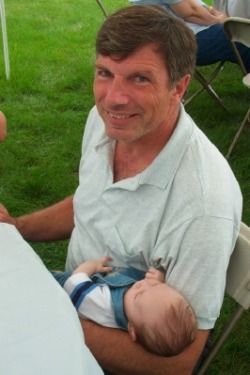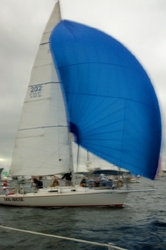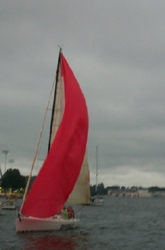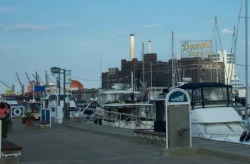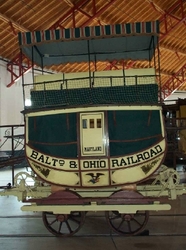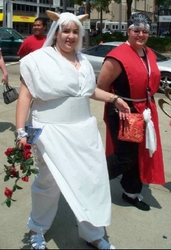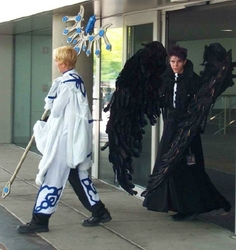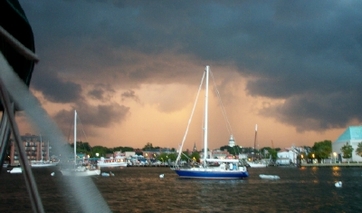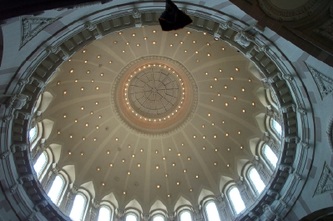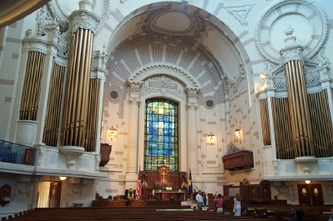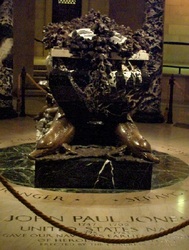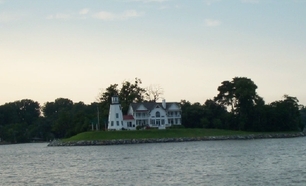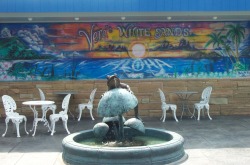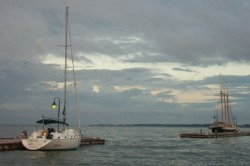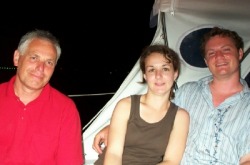
Morning fog at Hospitality Harbor
With all the time away from the boat in September, the past 2 weeks have been packed with activity, as we scramble to ready Orion for the trip south. Despite our best efforts, we missed our original planned departure date (which was to be just after the boat show on October 9th) and are currently still in Solomons waiting for a good weather day to depart. However, we’ve done most of the projects we had on our list and feel pretty good that we are ready to begin the next leg of our journey. We are once again without a car and must depend on other forms of transportation for the next few months. So, unless we can get someplace by water, foot, bike or mass transit, it’s out of reach.
Cruise Control for the Water
We spent the better part of 3 days installing the various components of the auto-pilot that we purchased in September. Most of the steps were pretty straightforward (although Raymarine would do well to have someone read their installation instructions before shipping the product).
We added the wheel unit to the steering wheel and drilled a few more large holes (!) in our fiberglass helm to accommodate the wheel motor (2-1/8”), the control panel (90mm), and the bracket that supports the wheel unit. (The 90mm hole for the control panel proved to be a problem, since we could only find 89mm and 92mm drill bits. So, David had to use the smaller size and carefully file away the extra millimeter so the unit would fit. It’s hard to know whether to be more annoyed at Raymarine for not considering this in their design or at the US for being the only country of any size that has not adopted the metric system.)
Cruise Control for the Water
We spent the better part of 3 days installing the various components of the auto-pilot that we purchased in September. Most of the steps were pretty straightforward (although Raymarine would do well to have someone read their installation instructions before shipping the product).
We added the wheel unit to the steering wheel and drilled a few more large holes (!) in our fiberglass helm to accommodate the wheel motor (2-1/8”), the control panel (90mm), and the bracket that supports the wheel unit. (The 90mm hole for the control panel proved to be a problem, since we could only find 89mm and 92mm drill bits. So, David had to use the smaller size and carefully file away the extra millimeter so the unit would fit. It’s hard to know whether to be more annoyed at Raymarine for not considering this in their design or at the US for being the only country of any size that has not adopted the metric system.)

Dave installs wires at the Nav Station
The next step was to run wires to the computer, the compass, the nav station, and the rudder. Most of these were fed through easily, with the exception of the larger gauge wire needed for the Central Navigation breaker on the Nav Station panel. This required one more wire to be fed through an already overstuffed passageway under the floor in the head. We finally managed to fish it through after several unsuccessful attempts and a bit of swearing.
Positioning the compass had to be done carefully, since it must be near the center of the boat, but far away from metal that would affect its accuracy (such as a cast iron keel or the engine, which also happen to be in the center of the boat). If we didn’t choose correctly, we might find that we would have to re-position the compass later, if it wouldn’t calibrate to the boat’s magnetic compass heading. We chose a position behind our port settee in the main saloon, which seemed to meet all the requirements. Equal care had to be given to the location of the computer, which we decided to put under our bed in the aft cabin.
However, by far the most complex installation was the rudder sensor. This component wasn’t a requirement in the previous version of the Raymarine auto-pilot, but has become more important with the S1. It has a spring-loaded arm that is supposed to move with the rudder to indicate its angle. Given our rudder configuration, this was a real challenge. (See pictures below.) David spent a bit of time talking to anyone who had done this before and wondering around Lowe’s, looking for something he could use to create the mount for the sensor and something that would attach to the rudder itself to hold the reference arm. The Raymarine installation diagrams (and most everyone else) assumed we had access to a point on top of the rudder post at its pivot point where we could mount the reference arm. However, our rudder post ran straight up to the deck where the emergency tiller attaches. This implied that we had to drill into the post to mount the guide arm there. David was not too keen about doing this. He finally talked to John (the marine electrician who helped us on several occasions) who suggested we mount a band around the rudder post. This seemed to work. When completed, everything had to be parallel between the reference arm on the rudder and the new sensor. This wasn’t easy to verify since the rudder sensor had to be manually held back against the spring at its mid-point while we measured the angles and distances. We also had to try to determine “square” when one of the corners of the square was the 3” rudder post. This caused us to resort to some of our high school geometry to try to verify we had it right.
However, by far the most complex installation was the rudder sensor. This component wasn’t a requirement in the previous version of the Raymarine auto-pilot, but has become more important with the S1. It has a spring-loaded arm that is supposed to move with the rudder to indicate its angle. Given our rudder configuration, this was a real challenge. (See pictures below.) David spent a bit of time talking to anyone who had done this before and wondering around Lowe’s, looking for something he could use to create the mount for the sensor and something that would attach to the rudder itself to hold the reference arm. The Raymarine installation diagrams (and most everyone else) assumed we had access to a point on top of the rudder post at its pivot point where we could mount the reference arm. However, our rudder post ran straight up to the deck where the emergency tiller attaches. This implied that we had to drill into the post to mount the guide arm there. David was not too keen about doing this. He finally talked to John (the marine electrician who helped us on several occasions) who suggested we mount a band around the rudder post. This seemed to work. When completed, everything had to be parallel between the reference arm on the rudder and the new sensor. This wasn’t easy to verify since the rudder sensor had to be manually held back against the spring at its mid-point while we measured the angles and distances. We also had to try to determine “square” when one of the corners of the square was the 3” rudder post. This caused us to resort to some of our high school geometry to try to verify we had it right.
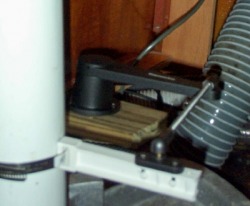
Rudder sensor for the auto-pilot
Since the auto-pilot required components be installed throughout the boat, almost every compartment in the boat was turned upside down for 3 days, with contents in piles everywhere. It was a relief when the last of components were put in place, so things could be returned to their proper location.
Although we haven’t completed our sea trial, we have completed the dockside calibration and the compass calibration successfully, so we know that the compass doesn’t need to be moved and we’re hopeful the first run will be successful as well.
Piling? What Piling?
Cathy began to regain her confidence at docking as we managed to dock the boat successfully 2 or 3 more times with the new method of backing into the slip at 1+ knots. However, we always had more help on board than would typically be present when we start traveling again. We had been advised that, if we had some rubrail, it wouldn’t be such a big deal if we ran against a piling on the way into the slip. (Hell, we might even want to use the piling to help with a turn. Cathy liked this idea.) This caused us to pursue adding some stainless steel rubrail to the sides of the current teak toe rail along the hull. We decided we needed to purchase 5 -12 foot lengths to cover the sides of the boat (assuming we cut one in half). However, we were running out of time to order online or even to order through a local West Marine or Boaters World. We finally found that the Alexandria West Marine store had the pieces we needed. Although this meant a couple hours of driving to pick it up, with it hanging out the back of our trunk, it appeared to be our only option. We also had to order the one foot ends separately, since no one in a 50 mile radius had those in stock. Before applying, we took a couple of days to put a couple of new coats of Cetol on the teak. The rails had had a rough summer and the beautiful finish that we started with in April had been worn away in many spots by the chafing of dock, anchor and fender lines during the summer storms. The refinished wood looked so much better.
The rails themselves went on easily once we moved the boat to the “T” at the end of the dock and enlisted the help of a third person (a fellow cruiser who had some time on his hands) to help hold the long rails and screw them to the wood. They look great, and will get their first test in the storm that’s supposed to blow in later this week, not to mention all those future dockings . . .
The Sailing Mecca – Annapolis Sailboat Show
Non-sailors may not understand what a big deal the annual Annapolis Sailboat Show is to the sailing community. It is held Columbus Day weekend every year in the heart of Annapolis, centered on “Ego Alley”, Annapolis main harbor. To allow all the boat manufacturers to display their boats in the water, large numbers of floating docks are deployed which makes all the sailboats accessible to the attendees by simply walking the show. Most cruisers who are headed south will delay their departure until after the boat show. Most vendors entice their shoppers with “Boat Show” prices, some of which are very good. There are talks by experienced boaters and experts on a variety of boat systems. It’s also an excellent time to talk to other cruisers to find out how they solved some problem or to get tips for the journey ahead.
Unfortunately, the day we wanted to go to the boat show was Friday – the same day a Nor’easter came howling through Annapolis. Winds were sustained at 25 knots with rain all day and temperatures in the 50’s. The two of us took different approaches to coping with the weather. Cathy chose a nautical route, deciding it was a good time to test her foul weather gear and suited up from head to toe in coat, bibs and boots. She stayed warm and dry, although anything in an exterior pocket was quickly drenched. David fell back on his Boy Scout days and decided to don shorts and hiking boots under his foul weather coat. He seemed to do OK, but was getting chilly by the end of the day. It’s hard to say which of us looked more odd.
Although the vendors are there to sell, sell, sell, our biggest finds of the day were not merchandise, but advice.
Water Torture
The night before attending the show, Cathy was rudely awakened by a new leak in the hatch over the bed, which prompted her to check all of the portlights on the boat. All but 2 were dripping. With the dry summer weather, we had virtually no problems with leaks until Ernesto hit. But this storm outdid Ernesto for water entering by unseen cracks. We took this up with the Lewmar folks at the boat show. The salesman smiled knowingly, as if we were just the latest in a series of soggy customers. He explained that we could apply some silicon to the outer seams of the portlights, which should solve the problem. In the event that the “keys” which locked them shut were also part of the problem, we could pop off an outer covering and seal those as well. The next nice day we were quick to put this suggestion into use, although the weather hasn’t tested it yet (until today).
Furling
We had been having a problem back at the end of the summer with our headsail furling mechanism. Based on some advice we received back then, we determined that the furling mechanism at the top of the furler wasn’t set properly. This was allowing the top of the sail to rotate on the furler, which it shouldn’t do, and was preventing us from furling the sail. We lowered the sail to check out the “car” that is at the top of headsail. The part of the car that prevents the sail from rotating had separated from the part of the car that holds the sail. We re-inserted it, and the sail worked fine, but David was never really comfortable that this solution was a permanent one. At the Facnor (furler manufacturer) tent, the salesman agreed that the pieces should not have separated and needed to be more permanently attached with glue or a screw. We are still trying to get clarification on how to do this from the company.
Who Will Buy?
We visited a number of other vendors, with some of the highlights being:
- David sought advice from Raymarine about the auto-pilot and suggested they improve their installation instructions.
- At Wichard (the French block* manufacturer that made all of the original blocks on our boat), we talked about the difficulty we had in find the blocks to replace those at the base of the mast. They don’t have model numbers on the blocks, and are an unusual design. *”Blocks” are the pulleys that are used to run the lines that control the sails.
- We found some solar-powered LED lights for the cockpit to give a small amount of light, mainly to keep from tripping when going in and out.
- We were able to reconnect with Jed and Page from Good Turns, LLC, who had a booth at the show. They had been our first guests to arrive by dinghy early in the summer.
Lectures
For the first time this year, we attended some lectures, which were of varying value and interest. The most interesting was probably Beth Leonard, a writer and sailor who has completed more than 90,000 miles sailing with her husband. We actually got to hear her again the next day, at the Seven Seas Crusing Association meeting. The other advantage of the lectures was that they were inside and therefore warm and dry.
We spent Saturday of Boat Show weekend attending the Seven Seas Cruising Association meeting. We learned about electrical systems from Nigel Calder, about circumnavigation from Beth Leonard, about surviving the Tsunami from Ed and Helen Muesch, and about women sailing by Suzanne Giesemann. They were all excellent presentations and well worth the trip as well as another day in the cold and wet weather.
Although we haven’t completed our sea trial, we have completed the dockside calibration and the compass calibration successfully, so we know that the compass doesn’t need to be moved and we’re hopeful the first run will be successful as well.
Piling? What Piling?
Cathy began to regain her confidence at docking as we managed to dock the boat successfully 2 or 3 more times with the new method of backing into the slip at 1+ knots. However, we always had more help on board than would typically be present when we start traveling again. We had been advised that, if we had some rubrail, it wouldn’t be such a big deal if we ran against a piling on the way into the slip. (Hell, we might even want to use the piling to help with a turn. Cathy liked this idea.) This caused us to pursue adding some stainless steel rubrail to the sides of the current teak toe rail along the hull. We decided we needed to purchase 5 -12 foot lengths to cover the sides of the boat (assuming we cut one in half). However, we were running out of time to order online or even to order through a local West Marine or Boaters World. We finally found that the Alexandria West Marine store had the pieces we needed. Although this meant a couple hours of driving to pick it up, with it hanging out the back of our trunk, it appeared to be our only option. We also had to order the one foot ends separately, since no one in a 50 mile radius had those in stock. Before applying, we took a couple of days to put a couple of new coats of Cetol on the teak. The rails had had a rough summer and the beautiful finish that we started with in April had been worn away in many spots by the chafing of dock, anchor and fender lines during the summer storms. The refinished wood looked so much better.
The rails themselves went on easily once we moved the boat to the “T” at the end of the dock and enlisted the help of a third person (a fellow cruiser who had some time on his hands) to help hold the long rails and screw them to the wood. They look great, and will get their first test in the storm that’s supposed to blow in later this week, not to mention all those future dockings . . .
The Sailing Mecca – Annapolis Sailboat Show
Non-sailors may not understand what a big deal the annual Annapolis Sailboat Show is to the sailing community. It is held Columbus Day weekend every year in the heart of Annapolis, centered on “Ego Alley”, Annapolis main harbor. To allow all the boat manufacturers to display their boats in the water, large numbers of floating docks are deployed which makes all the sailboats accessible to the attendees by simply walking the show. Most cruisers who are headed south will delay their departure until after the boat show. Most vendors entice their shoppers with “Boat Show” prices, some of which are very good. There are talks by experienced boaters and experts on a variety of boat systems. It’s also an excellent time to talk to other cruisers to find out how they solved some problem or to get tips for the journey ahead.
Unfortunately, the day we wanted to go to the boat show was Friday – the same day a Nor’easter came howling through Annapolis. Winds were sustained at 25 knots with rain all day and temperatures in the 50’s. The two of us took different approaches to coping with the weather. Cathy chose a nautical route, deciding it was a good time to test her foul weather gear and suited up from head to toe in coat, bibs and boots. She stayed warm and dry, although anything in an exterior pocket was quickly drenched. David fell back on his Boy Scout days and decided to don shorts and hiking boots under his foul weather coat. He seemed to do OK, but was getting chilly by the end of the day. It’s hard to say which of us looked more odd.
Although the vendors are there to sell, sell, sell, our biggest finds of the day were not merchandise, but advice.
Water Torture
The night before attending the show, Cathy was rudely awakened by a new leak in the hatch over the bed, which prompted her to check all of the portlights on the boat. All but 2 were dripping. With the dry summer weather, we had virtually no problems with leaks until Ernesto hit. But this storm outdid Ernesto for water entering by unseen cracks. We took this up with the Lewmar folks at the boat show. The salesman smiled knowingly, as if we were just the latest in a series of soggy customers. He explained that we could apply some silicon to the outer seams of the portlights, which should solve the problem. In the event that the “keys” which locked them shut were also part of the problem, we could pop off an outer covering and seal those as well. The next nice day we were quick to put this suggestion into use, although the weather hasn’t tested it yet (until today).
Furling
We had been having a problem back at the end of the summer with our headsail furling mechanism. Based on some advice we received back then, we determined that the furling mechanism at the top of the furler wasn’t set properly. This was allowing the top of the sail to rotate on the furler, which it shouldn’t do, and was preventing us from furling the sail. We lowered the sail to check out the “car” that is at the top of headsail. The part of the car that prevents the sail from rotating had separated from the part of the car that holds the sail. We re-inserted it, and the sail worked fine, but David was never really comfortable that this solution was a permanent one. At the Facnor (furler manufacturer) tent, the salesman agreed that the pieces should not have separated and needed to be more permanently attached with glue or a screw. We are still trying to get clarification on how to do this from the company.
Who Will Buy?
We visited a number of other vendors, with some of the highlights being:
- David sought advice from Raymarine about the auto-pilot and suggested they improve their installation instructions.
- At Wichard (the French block* manufacturer that made all of the original blocks on our boat), we talked about the difficulty we had in find the blocks to replace those at the base of the mast. They don’t have model numbers on the blocks, and are an unusual design. *”Blocks” are the pulleys that are used to run the lines that control the sails.
- We found some solar-powered LED lights for the cockpit to give a small amount of light, mainly to keep from tripping when going in and out.
- We were able to reconnect with Jed and Page from Good Turns, LLC, who had a booth at the show. They had been our first guests to arrive by dinghy early in the summer.
Lectures
For the first time this year, we attended some lectures, which were of varying value and interest. The most interesting was probably Beth Leonard, a writer and sailor who has completed more than 90,000 miles sailing with her husband. We actually got to hear her again the next day, at the Seven Seas Crusing Association meeting. The other advantage of the lectures was that they were inside and therefore warm and dry.
We spent Saturday of Boat Show weekend attending the Seven Seas Cruising Association meeting. We learned about electrical systems from Nigel Calder, about circumnavigation from Beth Leonard, about surviving the Tsunami from Ed and Helen Muesch, and about women sailing by Suzanne Giesemann. They were all excellent presentations and well worth the trip as well as another day in the cold and wet weather.
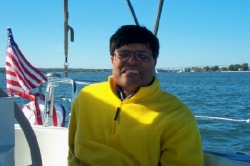
Padam joins us for a sail in the Patuxent
Cruising Company
Solomons is one of the stop-overs for cruisers heading south. We’ve seen untold numbers of boats pull in to provision and then head out for southern seas. The accents and the hailing ports tell us that many are coming internationally from Canada, England, France as well as domestically from New England and the Mid-Atlantic states. We’ve met a few of them, including George, who assisted us with the rubrail. Chris and Margaret, our neighbors here at Hospitality Harbor have decided to head south this fall as well, and plan to leave a couple of weeks behind us. We’ve been comparing notes and helping with preparations over the past few weeks as we get both of our boats ready.
We’ve also managed to spend at least a couple of days sailing on the Patuxent and the bay -- once with Dave’s cousin Don, his son Noah and some friends and once with a scouting parent from Troop 1577, Padam. There have been some beautiful, warm days this October, which has been a real gift.
Solomons is one of the stop-overs for cruisers heading south. We’ve seen untold numbers of boats pull in to provision and then head out for southern seas. The accents and the hailing ports tell us that many are coming internationally from Canada, England, France as well as domestically from New England and the Mid-Atlantic states. We’ve met a few of them, including George, who assisted us with the rubrail. Chris and Margaret, our neighbors here at Hospitality Harbor have decided to head south this fall as well, and plan to leave a couple of weeks behind us. We’ve been comparing notes and helping with preparations over the past few weeks as we get both of our boats ready.
We’ve also managed to spend at least a couple of days sailing on the Patuxent and the bay -- once with Dave’s cousin Don, his son Noah and some friends and once with a scouting parent from Troop 1577, Padam. There have been some beautiful, warm days this October, which has been a real gift.
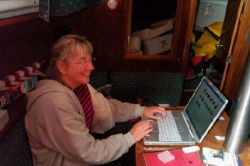
Cathy works on the website
Rain, Rain Go Away
The good news about the rain is that it has allowed us to get this web log entry written and posted. Also, Dave managed to purchase the Garmin charts for the rest of our trip and upgrade our existing charts. But, it’s time to get going, so we are looking for the rain to subside so we can shove off and move south. Our next update should find us somewhere in NC perhaps? We’ll see . . .
The good news about the rain is that it has allowed us to get this web log entry written and posted. Also, Dave managed to purchase the Garmin charts for the rest of our trip and upgrade our existing charts. But, it’s time to get going, so we are looking for the rain to subside so we can shove off and move south. Our next update should find us somewhere in NC perhaps? We’ll see . . .
